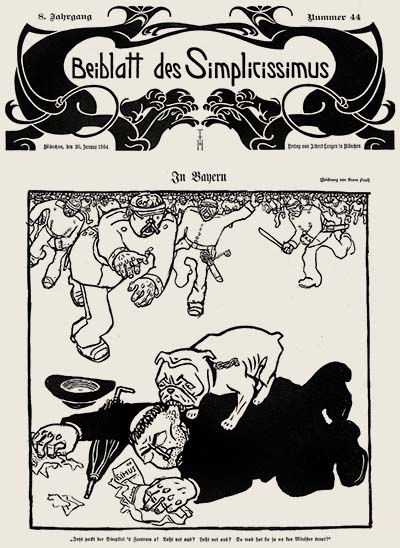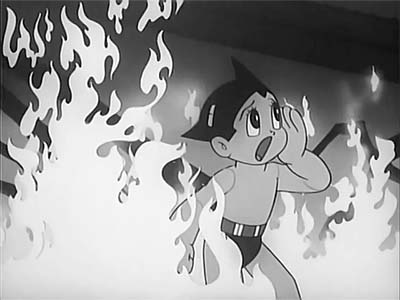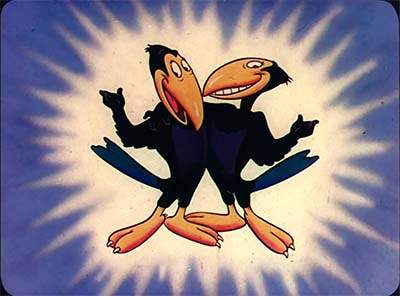LAST CALL! A new Bonus Archive goes online this weekend and this one goes away. Download it now while you can.

As a special thank you to our annual General and Student members, we have created a special page where we will archive past Reference Packs. There will be at least four reruns of complete RefPacks per year.
If you are currently on a quarterly membership plan, consider upgrading to an annual membership to get access to our bonus page with even more downloads. If you still have time on you quarterly membership when you upgrade to an annual membership, email us at…
membership@animationresources.org
…and we will credit your membership with the additional time.
Available to Student and General Members
PDF E-BOOK:

Simplicissimus Vol. 1![]()
December 30th, 1903 to March 2nd, 1904
Simplicissimus (Simpleton) was founded in 1896. It was the most audacious and daring caricature magazine of its day, lampooning the stiffness of officers of the military, religion, class divisions, loose social morals and inevitably, powerful political leaders. Its reckless determination to offend destined it for trouble, and it didn’t take long.
In 1898 Kaiser Wilhelm objected to a caricature of himself on the cover of Simplicissimus. He shut down the magazine, forced its publisher to flee to Switzerland, and threw the cartoonist, Theodor Heine in jail. Like a phoenix, Simplicissimus soon sprang up again, but in 1906 its editor Ludwig Thoma was convicted of attacking the church and was also jailed for a time. It continued to have legal troubles with the government and religious leaders throughout its many decades in publication, but these troubles only served to increase the circulation.

![]() Based in Munich, the staff of Simplicissimus included some of the best draftsmen and most forward thinking illustrators of the day. Bruno Paul was one of the most recognizable of the magazine’s artists. He was one of the founders of the Jugendstil movement and along with cartooning, he was an accomplished furniture designer and architect. Another brilliant contributor to Simplicissimus was Rudolf Wilke. His caricatures were keenly observed and unique. The personalities lept off the page. Ludwig Thoma specialized in satirizing life in in rural Bavaria; while Eduard Thöny and Ferdinand von Reznícek focused on military subjects and high society. Olaf Gulbransson was a Norwegian-born artist with a simple graphic line that belied the sophistication of his caricature. It was an amazing team of artists, and they produced thousands of incredible illustrations over the years on a tight weekly schedule.
Based in Munich, the staff of Simplicissimus included some of the best draftsmen and most forward thinking illustrators of the day. Bruno Paul was one of the most recognizable of the magazine’s artists. He was one of the founders of the Jugendstil movement and along with cartooning, he was an accomplished furniture designer and architect. Another brilliant contributor to Simplicissimus was Rudolf Wilke. His caricatures were keenly observed and unique. The personalities lept off the page. Ludwig Thoma specialized in satirizing life in in rural Bavaria; while Eduard Thöny and Ferdinand von Reznícek focused on military subjects and high society. Olaf Gulbransson was a Norwegian-born artist with a simple graphic line that belied the sophistication of his caricature. It was an amazing team of artists, and they produced thousands of incredible illustrations over the years on a tight weekly schedule.
When the Nazis came to power in the mid-1930s, Simplicissimus was an obvious target for silencing. The Nazis despised everything that the magazine stood for, but they didn’t shut Simplicissimus down. They purged it of the Jewish employees and weeded the ranks of its most radical writers and artists. Thomas Heine, who was responsible for creating the iconic bulldog mascot was the first to go. They succeeded in blunting its impact considerably, a blow from which the magazine never recovered. Simplicissimus ceased publication at the end of World War II, and was re-established for a while in the mid-1950s, but by that time it was pale shadow of its former self.
Click to access the…
Downloads expire after December 2023
DVD QUALITY VIDEO:

Astro Boy
Pilot Episode / 1963
Astro Boy (known in Japan as Mighty Atom) premiered on Fuji TV on New Year’s Day in 1963. It was immensely popular and established many of the concepts that later became known to be a part of the Anime style. Created by Osama Tezuka, the story was originally told in the form of manga comics which were published beginning in 1951 and continuing for three decades. Tezuka was influenced for the design of Astro Boy by Mickey Mouse, and you can see gags in the circus parade sequence that have been lifted from Fleischer cartoons.
The animation in this pilot episode is a model of economy. Notice how exposition is covered quickly in a series of quick static images, and how most of the focus is on the personality of the characters. Much of the animation consists of repeating 4, 8 and 16 frame cycles, but occasionally a sophisticated bit of personality animation or an expressive walk cycle is sprinkled in to keep things alive. Even though there are fewer drawings than in most animated films and TV shows, the drawings in Astro Boy are particularly well executed. Compositions, expressions and character posing is all first rate, and many of them are funny as well. The timing of the effects animation is worth studying for the way it cleverly reuses drawings without becoming too repetitive.
Independent animators would be well served to analyze the techniques used in this program. Many of the ideas for streamlining the storytelling and reusing drawings directly apply to the tight schedules required for internet cartoon series. We hope you find this to be useful in your own work.
Click to access the…
Downloads expire after December 2023
HD QUALITY VIDEO:

Heckle & Jeckle in "Sno Fun"
Terry-Toons / Eddie Donnelly (Dir) / 1951
During the early 1950s, Terry-Toons was suffering from a lack of inspiration when it came to coming up with premises for cartoons. They recycled stories from cartoons they had made decades earlier and even appropriated ideas from other studios. "Sno Fun" unashamedly imitates Tex Avery’s "Northwest Hounded Police" made five years earlier, substituting Heckle & Jeckle for Droopy and a French Canadian bulldog for the wolf.
But even though the story and gags are unimaginative, the animation is truly inspired. Jim Tyer animates the lion’s share of this cartoon and he successfully turns lead into gold. Tyer had his own sense for distorting the characters to anticipate big actions and makes tired gags seem fresh.
This particular video transfer was provided to Animation Resources by our Advisory Board member Steve Stanchfield and it is a revelation, because Terry-Toons usually look faded and grainy- but this 35mm print is sharp and clear with bright colors. This allows you to analyze Tyer’s animation frame by frame. Choose a scene that makes you laugh and break it down… study the drawings and timing. Notice how Tyer uses repeating rhythmic cycles of rolling eyes or flapping mouths to heighten the comedy. Volumes change depending on the need of the movement. His animation is less about moving characters through space than it is expressing movement through the characters. That is a totally different way of thinking about how to animate a film.
Many thanks to Steve Stanchfield for sharing so many treasures with us.
Click to access the…
Downloads expire after December 2023
More members mean we can bring you more special downloads.
Fall is time to save when you join Animation Resources as a student member. For the next couple of weeks our Student Membership will be discounted to only $60/year! Best of all, you will continue to get that savings every year you renew as a student for up to three years. Yes, this applies to full time educators too. Why should you join? Each day we’ll be highlighting more reasons why you should be a member of Animation Resources. Bookmark us and check back every day.

![]() STUDENT MEMBERSHIP
STUDENT MEMBERSHIP![]()
Discount Ends Nov. 6th!
$70/year $60/year (recurring)
FREE SAMPLES!![]()
Not Convinced Yet? Check out this SAMPLE REFERENCE PACK! It will give you a taste of what Animation Resources members get to download every other month!
There’s no better way to feed your creativity than to be a member of Animation Resources. Every other month, we share a Reference Pack that is chock full of downloadable e-books and still framable videos designed to expand your horizons and blow your mind. It’s easy to join. Just click on this link and you can sign up right now online.
https://animationresources.org/membership/levels/






























